WINDJAMMER sails again! | Read more at in70mm.com The 70mm Newsletter |
| Written by: Rick Mitchell, Hollywood, USA. | Date: 07.09.2010 |
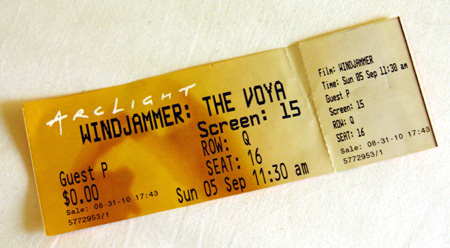 Image by Tom March Image by Tom March"WINDJAMMER: THE VOYAGE OF THE CHRISTIAN RADICH" sailed across the screen of the Cinerama Dome Sunday morning, Sept. 5, 58 years and some months after it first sailed across the screen of the reasonably close by Chinese Theater, then from three synchronized panels of 35mm film, this time digitally from a 35mm anamorphic print combining all three panels. It had been filmed in CineMiracle, a rival process to Cinerama developed by National Theaters, the only film in the process, which was later bought out by Cinerama. | More in 70mm reading: "Windjammer" @ the Dome "Windjammer" Press Release Dave "Cinerama" Strohmaier Greg Kimble Louis de Rochemont Christian Radich "Windjammer" cast and credits "This is Cinerama" in70mm.com's Cinerama page Internet link: |
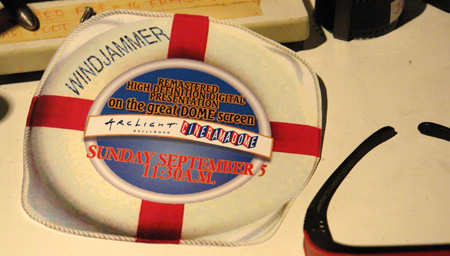 Image by Tom March Image by Tom MarchThe only real difference between the two processes was that the side CineMiracle cameras were aimed at mirrors, which minimized some of the problems with Cinerama. Projection was also done via mirrors and the projectors could be installed in one booth, as opposed to the three needed for Cinerama. (I won't go further into technical details, which can best be found at widescreenmuseum.com) Because of the similarities in the processes, most screenings of "WINDJAMMER" were held in Cinerama theaters. "WINDJAMMER" was produced by Louis de Rochemont whom had been a producer for THE MARCH OF TIMES newsreels of the Thirties, which occasionally dramatized events or aspects of events that had not been recorded by motion picture cameras. | |
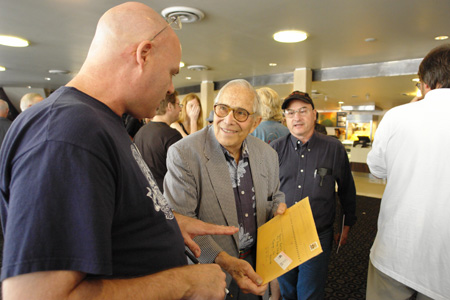 Norman Karlin, Cinerama film editor. Image by Tom March Norman Karlin, Cinerama film editor. Image by Tom MarchIn the mid-Forties he transformed this approach into a series of what came to be known as semi-documentaries, dramatizations of real life, usually crime stories, such as "THE HOUSE ON 92ND STREET" (1945), "13 RUE MADELEINE" (1946), and "WALK EAST ON BEACON" (1951). This mixture of documentary and dramatization was apparently a key aspect of his approach to the second Cinerama film "Cinerama Holiday" (1955), which contrasted the adventures of an American couple in Europe and an English couple in the United States, and "WINDJAMMER", dealing with a round trip voyage of a ship full of Norwegian cadets to the Caribbean and back, is clearly an expansion of that idea. | |
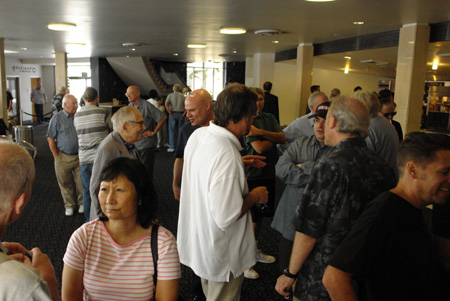 Image by Tom March Image by Tom MarchThe film is in many ways a relic of its time and an interesting reminder of a peaceful calmer period, despite an interlude with the United States Navy, which does include a POV of a submarine diving and surfacing, which David Lean reportedly called the greatest shot he'd ever seen. "This is Cinerama" had of course set the pattern for these films and given the unavailability of others, it's difficult to really put "WINDJAMMER" in perspective. TIC was essentially an experiment, to a large extent cobbled together. "WINDJAMMER" is more structured and many of the events depicted in the film are obviously preplanned, some clearly scripted, albeit likely the night before. The obviousness of these may be a problem for those who've grown up with the supposedly realistic "cinema verite" documentaries introduced in the Sixties, or worse, today's reality tv. As in "TIC", there are "human interest" bits that often seem a bit hokey today, such as when the ship's mascot goes ashore on its own and has to be tracked down. And the cadet who is also a piano student who hopes to get a letter of commendation from Arthur Fiedler and ends up playing with him. | |
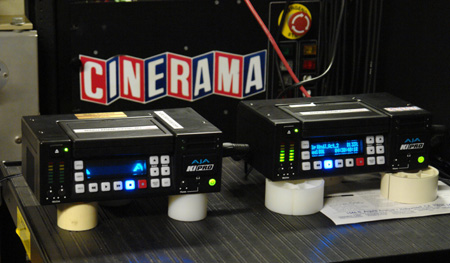 AJA Ki-PRO Hard drive file player for Windjammer and a safety back-up. Image by Tom March AJA Ki-PRO Hard drive file player for Windjammer and a safety back-up. Image by Tom MarchWhat really excites is the photography of the ship and the onboard activities of the cadets. Given the size and weight of the camera, it's amazing the shots the crew, which included Gordon Willis, obtained, including shots from up in the rigging. And although they built sets for a few shots, it's amazing the shots they did get not only inside the Christian Radich, but also inside the US submarine and a battleship. | |
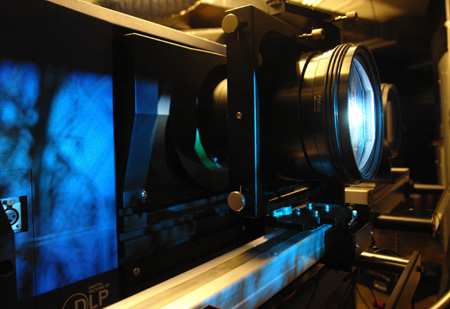 Image by Tom March Image by Tom MarchInterestingly, unlike with Cinerama as late as its last two films, composition and staging was not based around hiding the dividing lines but on the best composition for the shot. Like Cinerama, the exclusive use of 27mm lenses sometimes leads to awkward results when subjects get too close to the camera. But at other times, the images on a big wide screen have an impact almost never seen in contemporary films with their overuse of tight long lens closeups. And as the film is not sliced and diced, one is allowed time to really soak in the images. This is particularly noticeable in several songs, with the singers spread across the screen, all played out in a single shot and you don't miss not having a cut within it. The only exception to this approach was a sequence celebrating New York City done by a famous cameraman of the time, Weegee. These were quick cuts done with an image in each panel as in a triptych in the manner that would become briefly popular after a version of the technique was later used in the World's Fair film "A PLACE TO STAND" (1967). | |
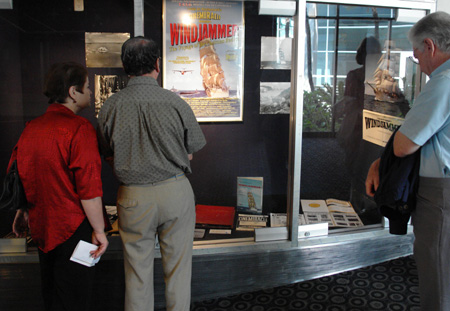 "Windjammer" display. Image by Tom March "Windjammer" display. Image by Tom March"WINDJAMMER" may actually have been the most popular of the films shot in three panel processes, getting international bookings as late as 1968. And, aside from the dramatic Cinerama films, it was the one most likely to have a life beyond roadshow engagements. In response to requests for it, Pacific Theaters, which got the rights to the film when it bought Cinerama, Inc., considered a trial revival in the early Seventies, it might have been the first three panel film to play the Cinerama Dome, but there were technical complications. Instead, they booked a run using only the center panel at the Dome and the audience nearly rioted. However, there was interest in a 35mm anamorphic release in Europe and so Linwood Dunn, ASC generated an internegative for this by rear projecting a CineMiracle print using three Cinerama projectors. (Dunn had done the 65mm internegative of "THIS IS CINERAMA"; there is some debate about the chronology of this vs. "WINDJAMMER", also the method he used. He told me personally that he had he had used rear projection for the "TIC" conversation but other sources claim he did that on an optical printer. However, prints were used in that instance as well.) A badly faded print from this internegative in the archives of the Swedish Film Institute became the source of this "reconstruction" supervised by Dave "Cinerama" Strohmaier. | |
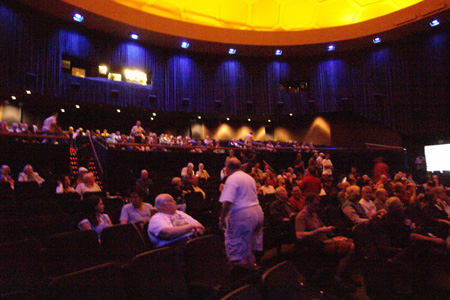 The famous Cinerama Dome. Image by Tom March The famous Cinerama Dome. Image by Tom MarchThe print was telecined and color corrected and cleaned up as much as possible by Dave and Greg Kimble. The seven track stereo master had been preserved in the late Nineties and had to be slowed down and pitch corrected to properly sync with the picture, which had been shot at Cinerama's 26 fps but had been transferred at 24 fps. (This has been done for the tracks used for contemporary screenings of "TIC" and "HTWWW" and Warner's "HTWWW" DVD.) They were able to get the 35mm prologue, which the Swedish Institute print didn't have, from a collector, and the venerable Martin Hart of widescreenmuseum.com reconstructed credits that were missing. (This is a simplified condensation of a process that took an amazing six months!) The goal at this point is to ultimately release the film on Blu-Ray DVD in Dave and Greg's patented "Smilebox" format, which recreates the effect of seeing these films on a deep curved screen, with a 5.1 stereo track, but... | |
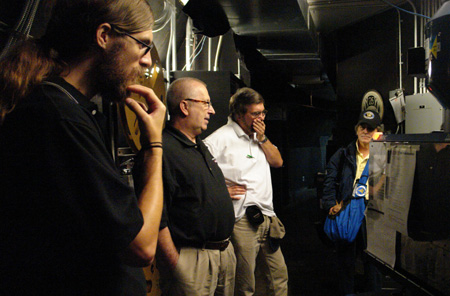 Casey Wright, John Sittig, Dave Strohmaier and Roy Wagner in Cinerama Dome's projection room. Image by Tom March Casey Wright, John Sittig, Dave Strohmaier and Roy Wagner in Cinerama Dome's projection room. Image by Tom MarchThe Dome presentation used an HD version which has also been successfully shown in Oslo (Norway) and Aalborg (Denmark). A 2K projector was used, and given the source material, looked extremely good on the Dome's huge screen. @300 attended, including many from out-of-town and out-of-the US, quite a turnout for a screening advertised entirely by word-of-mouth! A digital cinema version is being made available for revival houses and other interested venues, meaning, after 58 years "WINDJAMMER" may finally sail across a screen in Lexington, KY! | |
| Go: back - top - back issues - news index Updated 22-01-25 |
